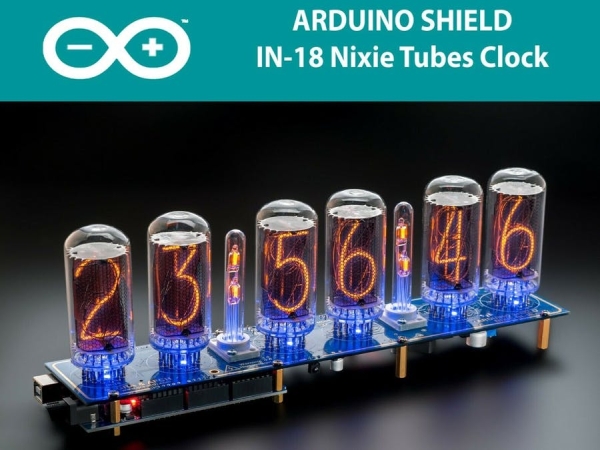Build your own Nixie tube clock/thermometer/display with ease.
Story
We set out to create a Nixie clock or just an information indicator on the largest ex-Soviet IN-18 tubes as an Arduino shield-compatible with both Uno and Mega boards.

After a long reading of lots of information about IN-18 tubes on the Internet, we found out that there’s existing issues with so-called “blow glow” and “poisoning” of the tubes.
These two topics discussed considerably on various forums and the main question stands why such effects occurs.
Among possible causes may be: poor supplying voltage, inappropriate supplying current, tubes wearing, switching schemes flaws, unsuitable types of drivers, imperfect control algorithms, untuned types of multiplexing (dynamic or direct – static) and others.
Considering all listed, it was quiet difficult to understand what actually causes the problems of stable usage of these large and beautiful tubes.
Previously we have dealt successfully with the smaller Nixie tubes such as IN-12 and IN-14 and they had no such problems.
So it goes and we have built the first prototype on ex-Soviet IC K155ID1 SN74141 driver. This particular driver is actually built specially for Nixie tubes, but in spite of that, a number of problems immediately arose. Low brightness of the tubes, “blue glow” in the form of dots, and most importantly and disappointing, a very short tubes lifespan are among of those problems.
We tried both multiplexed and direct tubes control methods. And immediately discarded the scheme with multiplexing because of the low brightness of the tubes and more complex software implementation for this method.
However it has its advantages such as fewer components and as a result lower cost. But we decided to use the scheme with direct control as more progressive.
Next came the stage where we tried almost all of the specialized driver circuits available on the market for managing high-voltage loads for the tubes.
In the process we found out that there were no driver with push-pull outputs that could suit our needs!
For large Nixie tubes such as IN-18, Z5660M, ZM1042, Z568 it takes a drivers with an open collectors (open-collector) or open-drain outputs to work.
That is, those in which one of the output states is a logical zero, and the second is a Z-state.
In addition, the driver should be able to provide the required current for the tubes, which must be at least 10 mA for a direct control circuit scheme and at least 20 mA for a circuit with multiplexing scheme.
In the process of some trails and errors we finaly stoped at HV5122PJ microcircuit in the PLCC44 package that has meet all our requirements at most. It has 32 outputs wich allows assembling the clock on 6 Nixie tubes with 4 separating dots (e. g. Columns) using only two of those microcircuits.
One tube requires 10 control output legs and 6 Nixie tubes therefore requires 60 output legs. Since two drivers, with 32 legs each, have 64 terminals overall, it means we have 4 terminals left for individual control for each of the 4 dividing points.
Clocks assembled according to the scheme with direct control of the tubes and based on two IC registers HV5122PJ had no problems with “blue glow” dots and low level of tubes brightness.
Read more: ARDUINO CLOCK ON IN-18 NIXIE TUBES WITH A LONG SERVICE LIFE
